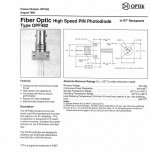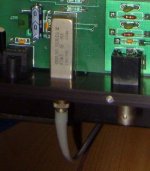I mean the AT&T fiber optic receiver - comments suggest this is the most transparent sounding input option on the DAC, and no - it's not a toslink input 
I have a feeling that I may have tracked down the device in question - CTS 1361AAC - unfortunately it's obsolete and seems very difficult to get. The prices I've seen ($60-70US) clearly warrant the statement in the Owners Manual - "It is a very expensive part, and we will charge for its replacement."
I've found a datasheet so I'll leave an empty footprint on the pcb in case I manage to track one down at reasonable cost.
I have a feeling that I may have tracked down the device in question - CTS 1361AAC - unfortunately it's obsolete and seems very difficult to get. The prices I've seen ($60-70US) clearly warrant the statement in the Owners Manual - "It is a very expensive part, and we will charge for its replacement."
I've found a datasheet so I'll leave an empty footprint on the pcb in case I manage to track one down at reasonable cost.
Try these
Also this thread should be in the Digital section
Yes I agree it's the most transparent, I can use spidf B&C coax, toslink or AT&T ST glass fiber optical and it is by far the better sounding.
Cheers George
http://www.optekinc.com/viewparts.aspx?categoryID=3
Also this thread should be in the Digital section
Yes I agree it's the most transparent, I can use spidf B&C coax, toslink or AT&T ST glass fiber optical and it is by far the better sounding.
Cheers George
http://www.optekinc.com/viewparts.aspx?categoryID=3
Attachments
Hi George,
thanks for the pic. It seems that variants of the 1361AAC were made by a number of companies. The implementation shown in the D1 schematic is very similar to the ODL50 datasheet attached, so it seems something ODL50 compatible will work.
My intent is to put together a fairly straight D1 clone (a D1 clone without enhancements?) based on the Rev 1 schematic that Pass Labs had on their site a few years back. Out of respect for Nelson and Wayne I prefer to post questions relating to their work in the Pass Labs forum.
cheers
Paul
thanks for the pic. It seems that variants of the 1361AAC were made by a number of companies. The implementation shown in the D1 schematic is very similar to the ODL50 datasheet attached, so it seems something ODL50 compatible will work.
My intent is to put together a fairly straight D1 clone (a D1 clone without enhancements?) based on the Rev 1 schematic that Pass Labs had on their site a few years back. Out of respect for Nelson and Wayne I prefer to post questions relating to their work in the Pass Labs forum.
cheers
Paul
Attachments
The optek 482 is a bare photodiode so would need support circuits to output something useful... The RX modules contain a photodiode, preamp and output buffer.
As far as I can determine, you need something that has similar cable interface, and bandwidth specs to the ODL series II - 1mbit/s -50mbit/s transfer rates, compatibility with 62.5/125um optical fibre, plus TTL outputs...
The following is from the ML No31 sales information:
It doesn't sound like a glowing recommendation for the ST interface.
Based on the "tip" of using higher bandwidth HP parts, it might be worth investigating the Avago HFBR-2416 / HFBR1414 pair.
cheers
Paul
As far as I can determine, you need something that has similar cable interface, and bandwidth specs to the ODL series II - 1mbit/s -50mbit/s transfer rates, compatibility with 62.5/125um optical fibre, plus TTL outputs...
The following is from the ML No31 sales information:
ST-optical digital interconnection was designed by AT&T for computer networking. Though not optimal for audio, it has certain advantages over digital interfaces found on some equipment. ST has a wider bandwidth than the more common EIAJ optical standard (often referred to by Toshiba's "Toslink®" trademark) and the coupling transformers used in most S/PDIF interfaces. It also provides ground-noise isolation often lacking in poorly designed electrical interfaces, and ST generally uses glass-fiber rather than plastic-fiber cables. ST is also recommended when digital-interconnection distances greater than fifty
feet are required.
The ST implementation in the N° 31 uses Hewlett-Packard parts with twice the bandwidth of the AT&T parts, yet is fully compatible with AT&T receivers. This 100MHz bandwidth is less than half that of the AES/EBU and SPDIF circuitry on the N° 31, but it may perform better with processors with poorly implemented electrical inputs.
It doesn't sound like a glowing recommendation for the ST interface.
Based on the "tip" of using higher bandwidth HP parts, it might be worth investigating the Avago HFBR-2416 / HFBR1414 pair.
cheers
Paul
50mbit/s is still oversized...  But may be - if you can really hear the benefit of higher bandwidth we should look at SFP-Modules like Finisar (over 4 GB/s). I talked to someone from Finisar. Should work. But I ask myself if it isn't extreme oversized...
But may be - if you can really hear the benefit of higher bandwidth we should look at SFP-Modules like Finisar (over 4 GB/s). I talked to someone from Finisar. Should work. But I ask myself if it isn't extreme oversized...
I also asked at CTS, what happened with their module... I will post it...
I also asked at CTS, what happened with their module... I will post it...
I think the motivation for higher bandwidth part was availability rather than audibility  The signal bitrate required for 44.1khz across spdif is 2.8mhz, so even a 5MBd part should be sufficient for this.
The signal bitrate required for 44.1khz across spdif is 2.8mhz, so even a 5MBd part should be sufficient for this.
If you not worried about compatibility with other ST equipped gear you can use whatever modules you like on the link.
If you not worried about compatibility with other ST equipped gear you can use whatever modules you like on the link.
My problem: I have in all components ST-connectors. But I don't know which, because I didn' built them in... and I don't get any information about this fact... No (!) information on the connectors ... 
Because of the acoustic behaviour I don't want to miss this stuff. But I must do it for my own. So I think, I will make things (up to now probably 5 MBd) better ...

Because of the acoustic behaviour I don't want to miss this stuff. But I must do it for my own. So I think, I will make things (up to now probably 5 MBd) better ...
There is an app bulletin from HP with lots of information on sub-155MBs fiber links:
http://www.secomtel.com/UpFilesPDF/PDF/Agilent/PDF_DOCS/FIBEROPT/FIBROPT/05_APPS/Ab78.pdf
It mainly focuses on the hfbr-2404/2416 parts but should be useful even with other modules.
http://www.secomtel.com/UpFilesPDF/PDF/Agilent/PDF_DOCS/FIBEROPT/FIBROPT/05_APPS/Ab78.pdf
It mainly focuses on the hfbr-2404/2416 parts but should be useful even with other modules.
Thanks. Looking at the schematic at figure 21 (have still downloaded the gerber-files), this way seems to me to be too wasteful. Doubtful if this makes things better...!? In this case I would think about a galvanic isolated 75 Ohm BNC connection 
The old version needs 2-3 electronic parts ...
The old version needs 2-3 electronic parts ...
the app notes need some "interpretation" I think. If you are using a CS8412/4 the chip already has differential inputs, so the main requirement appears to be a limiting opamp to boost the output to useable levels.
Obviously a TTL output device would be easier to use. The trick is finding one with a 50Mbps bit rate.
Obviously a TTL output device would be easier to use. The trick is finding one with a 50Mbps bit rate.
This is getting way off topic for the Pass Labs Forum... The original question was specifically about a component used in the Pass Labs D1, which was marginal to begin with.
It might be an idea to start a more general thread on Fibre Optic in the Digital section as I'm sure there are members who have something useful to contribute to the topic.
I really don't have the knowledge to give you any kind of reliable opinion on the datasheet schematics. I've only read and understood enough to work out which ones might possibly be suitable.
It might be an idea to start a more general thread on Fibre Optic in the Digital section as I'm sure there are members who have something useful to contribute to the topic.
I really don't have the knowledge to give you any kind of reliable opinion on the datasheet schematics. I've only read and understood enough to work out which ones might possibly be suitable.
- Status
- This old topic is closed. If you want to reopen this topic, contact a moderator using the "Report Post" button.
- Home
- Amplifiers
- Pass Labs
- D1 questions - AT&T receiver?

